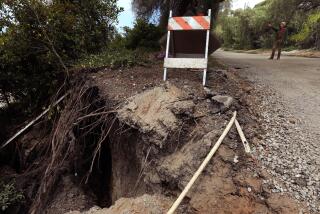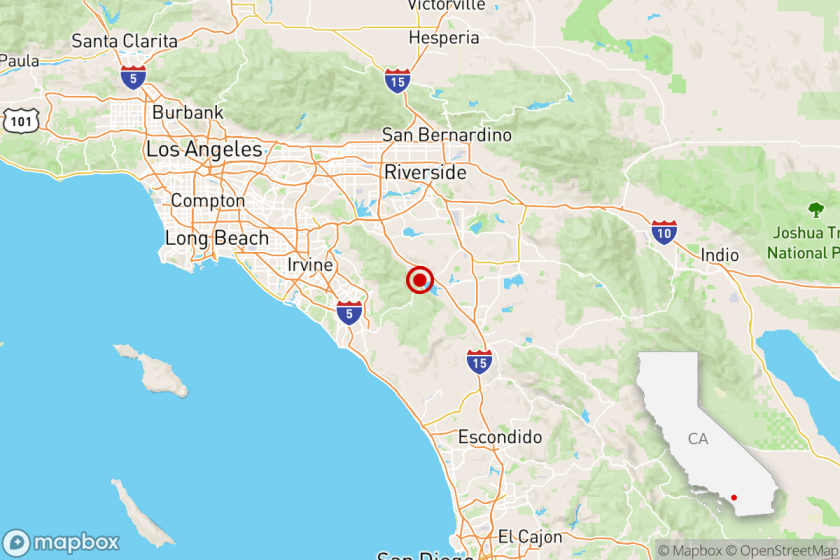‘94 Quake Damage to Sewer Lines Still Found
Public works officials leading a massive effort to repair quake-damaged sewer lines across Los Angeles say they have uncovered nearly twice as much damage as originally estimated, requiring an additional $53 million and up to three more years of work.
As originally proposed, the $147-million repair project was already described by officials as the largest sewer repair program in the city’s history. The project will now cost $200 million, all paid for with federal funds.
“It was a rough estimate and we’ve had to go back to [the Federal Emergency Management Agency] twice to ask for an extension,” said Hagop Yepremian, who is managing the city’s damage assessment efforts.
Yepremian and other city officials had estimated in 1995 that the powerful Northridge earthquake had sent cracks along 150 miles of the city’s sewer lines, weakening the pipes and increasing the likelihood of leaks. The repairs were expected to be completed this summer.
But city officials now estimate that up to 285 miles of line have been damaged, requiring three more years of work.
The challenge for public works officials is to complete the remaining work with as little traffic and neighborhood disruptions as possible.
But the hope is that they find no more damage.
“I don’t know what is going to happen in two years,” said Andy Badalian, a program manager for the city’s Public Works Department. “‘We could find more.”
Like the rest of the damage caused by the Jan. 17, 1994 earthquake, the cracks in the sewer system did not follow a pattern. Lengths of sewer lines in some areas survived without any damage. In other areas, pipes completely collapsed, blocking sewage lines for days.
Officials say whatever sewage has leaked from the pipeline cracks has not contaminated the city’s ground water. The most severely damaged pipes were repaired soon after the quake, they said. Most of the remaining repairs are for smaller cracks that threaten the integrity of the system in the future.
The sewer system damage has been identified through the use of a small remote-controlled video camera that crews pull by cables through the pipes. Workers in nearby trucks see the images from the cameras and take note on the size and location of the cracks.
After the quake, crews began assessing the damage starting at the epicenter of the temblor in Northridge. They also focused on areas where the quake damage on the surface was heaviest.
To no one’s surprise, the video cameras showed that much of the worst damage was near the epicenter in the San Fernando Valley. But heavy damage has also been found on the Westside, near the location where the Santa Monica Freeway collapsed during the quake.
In December, public works officials reached a self-imposed deadline to complete the damage assessment work. They had examined about 750 miles of sewer lines and began to wrap up the operation.
But Yepremian said the farther the remote-controlled cameras ventured from the epicenter, the more damage they found. The cameras have videotaped 1,900 miles of the city’s 6,500-mile sewer system. City officials estimate that 15% of the lines that have been examined are damaged.
Federal officials originally set a June deadline for the city to file a funding request for the repair work. But because of the discovery of additional damage, city officials asked and received an extension until September.
Public works officials now say they are asking for a second extension until December to ensure that all the damage has been found and all the repairs will be funded.
A handful of contractors are making the repairs using a high-tech method that involves pulling a special plastic liner through the damaged pipes and then blowing steam through to fuse the liner into place. A remote-controlled cutting device is then sent through the pipe to cut openings for the residential sewage connections. This method causes little disruption because it is done mostly at night, with no need to dig up the streets.
But most contractors who have been hired to repair the pipes rely on old-fashioned sweat and elbow grease. They dig 6-feet to 10-feet-deep trenches along the center of the street and send workers down to remove the damaged sections and replace them with new lengths.
Contractors normally divert the flow of sewage to nearby lines before they cut into the cracked sections. They also notify nearby residents not to use their toilets or sinks until the work is completed.
But Milemko Eres, a 29-year-old worker on one of those repair jobs, said he and his colleagues must occasionally endure the putrid odor of raw sewage when nearby residents decide to use their toilets.
“It’s kind of tough but we can’t all work in an office,” he said.
Work for Eres and other sewer repair crews has been particularly difficult during the record-breaking temperatures. Eres said he has gotten used to the heat. What he still can’t stomach is climbing into the 10-foot-deep trenches in the middle of the road to replace the cracked clay sewer pipes.
“It’s way worse down there,” he said. “It’s humid. There is no air. It feels like a jungle.”
So far, Eres said the only surprise he has come across is discovering an old hammer and empty liquor bottles in the trenches.
“You don’t find any gold down there,” he said. “If I did, I wouldn’t be here. I’d be gone.”
Ricardo Garcia, 35, a sewer repair worker at a repair job in Reseda, said he does the work because of the pay. “That is why I put up with it.”
He said he earns $26 an hour but still wonders whether it’s worth climbing down the trench. “It’s dangerous down there because the walls could cave in,” he said.
Tom McKissick, a veteran inspector with the city’s sewer repair program, said the city has imposed rigorous safety standards to prevent injuries.
He also makes sure that workers do not overexert themselves in the heat, he said.
Because the crews can dig a trench, replace a section of pipe and fill up the trench in less than a day, the disruption to traffic is usually only temporary.
J.P. Ellman, chairwoman of the city’s Public Works Commission, said she has received few complaints about the disruption caused by the repair work.
At a recent job in Reseda, Fred Kibler, a retiree, watched from his yard as a crew used a bulldozer to move a waist-high pile of sticky mud off his lawn and into a trench.
He said he was fascinated by the way the crew fixed the pipe so quickly and wasn’t worried about the mess they had made on his yard.
“It’s not a problem,” he said with a smile, “as long as they clean it up before they leave.”
More to Read
Sign up for Essential California
The most important California stories and recommendations in your inbox every morning.
You may occasionally receive promotional content from the Los Angeles Times.







